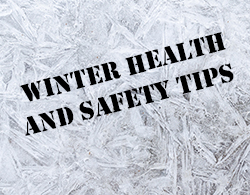Health and safety is a fundamental part of best practice in the workplace, and employers are responsible for the safety and welfare of the people working for them.
However, winter brings colder, wetter weather, and darker days, which can create additional health and safety issues which you should consider.
To help our customers through the winter months, we have created a list of winter weather health and safety tips, so you can look after your employees’ wellbeing this season.
Winter health and safety hazards The darker nights and wetter weather associated with winter can create a number of potential safety risks that you will need to combat. Issues you will need to look out for include:
- Slips and trips – wet weather makes surfaces more slippery while darker nights make hazards harder to see
- Road accidents – Wet roads and bad weather can create hazardous driving conditions
- Risk of illness – Exposure to cold weather conditions, especially if workers are operating outside, increases the likelihood of members of staff getting ill. Sickness absences from work can have a negative impact on a business
Winter weather health and safety tips
Fortunately, there are a number of measures that you can take to ensure these hazards are combated and the welfare of your employees is intact. Follow our top winter safety tips below and ensure that you stay safe this winter:
Increase the levels of lighting. To prevent slips and trips, you need to make sure employees have a well-lit working environment, which is harder to do in the winter months and darker nights. Survey the outdoors and indoors of your premises, and identify where additional lighting could be installed. Speak to members of staff and see if they struggle with visibility in any parts of their workspace, and add additional lighting where needed.
Tackle slippery surfaces. To reduce the risk of slip and trips, slippery (or potentially slippery) surfaces need to be well maintained. For indoor areas, make a member of staff responsible for drying-up floors and ensuring that slippery areas are clearly marked. Find out more about our mops and safety signs.
For outside your premises, activity may need to be more proactive. Keep an eye on weather forecasts and if there’s a chance it’ll be below freezing, make sure to grit and salt the paths to prevent trips and slips, as well as roads if you’re on private land to reduce the risk of road accidents.
Offer warm uniforms and clothing. If you provide a uniform for the people you employ, it’s important to make sure their clothing is warm and suited for the work they are undertaking. For staff working outside, make sure to provide them with waterproof workwear and coats and jackets to keep them warm and dry. Employees working indoors may still feel cold and draughts, so offering them warmer options for their uniforms, like a workwear fleece will keep them cosy, and reduce the risk of illness.
Monitor and plan out driving conditions. Planning is key when it comes to driving in cold and wet winter weather conditions. Wherever possible, plan routes to avoid particularly congested areas, or roads that are likely to not be gritted.
Driving in more difficult conditions is also more stressful on the driver, so make sure you provide team members with a list of winter driving safety tips, and explain them thoroughly to your employees. Make sure to allow for more travelling time than usual, and add additional rest stops and breaks to help reduce tiredness.
It is also helpful to set up procedures for how to handle emergencies in winter weather, so be sure to share this with your employees so that action can be taken confidently and consistently by all staff. You should also make sure to outline cases where conditions are too severe, and when employees shouldn’t drive at all.
Develop procedures. While you can take action to minimise risk, having the right procedures in place will help you to ensure you can correctly manage any incidents that do happen. Make sure your winter health and safety procedures include the following:
- Identify areas of potential risk and list steps to follow to ensure that the risk is minimised
- Establish who is responsible for winter health and safety activity and identify any training needs they may have to complete their job effectively
- Identify key performance indicators (KPIs) that will show you that the plan is performing correctly
- Schedule time to monitor and review the plan against these KPIs, and adapt your approach if it’s not working well
- Communicate to all members of staff on all aspects of health and safety procedures to staff members, so they know what to do if an incident occurs
We hope you have found our winter health and safety guide helpful, and we have given you some useful tips for staying safe in the colder months. Make sure to check out our range of cold weather essentials to stock-up on everything you need. If you have any questions at all, please don’t hesitate to contact our team.





Leave a comment